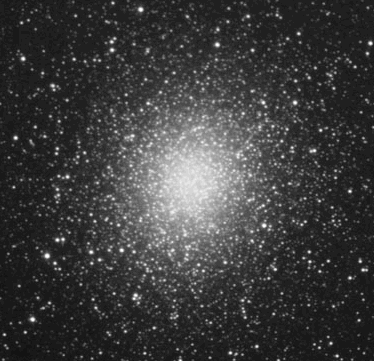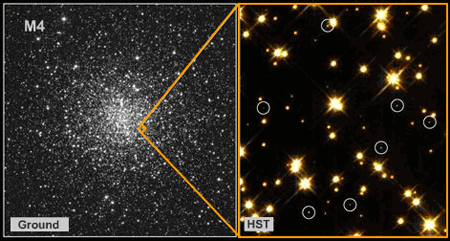Like
open clusters, globular clusters give
astronomers a unique insight to how stars evolve.
Globular star clusters are found orbiting the center
of
our galaxy in the halo.

(Image credit: Brooks/Cole Thomson Learning)
The yellow dots are the distribution
of globular clusters.
They are generally comprised of old, metal poor
stars - that is contain little elements heavier than
helium. This means globular clusters formed a long
time ago, before our galaxy contained more heavy
stars. By contrast, open clusters have more heavier
metals.
Here are some examples of globular clusters:

(© 2005 Russell Croman,
www.rc-astro.com)
The image above is of one of the
most dramatic clusters around - Omega Centauri.
The image below is of
M56, and
contains stars that are more red.

(© 2005 Russell Croman,
www.rc-astro.com)
Until recently, we have been able to spy a look
at the core of a globular cluster.

This
Hubble Space Telescope image of
M15 shows what
appears to be a concentration of stars at the very
center. This has led some to suggest that a black
hole is at the heart of this (and others) cluster.
What provides insight to this is the high
concentration of white dwarfs found.

This image of
M4 shows a ground view as well as a
Hubble Space Telescope image. The HST image shows at
least 7 white dwarfs (circled). Just like open
clusters, astronomers can use a
CMD to determine
cluster age:

(Image credit: Brooks/Cole Thomson Learning)
Because globular clusters are old, it will be rare
to see the
CMD distribution like the one on the
left. The distribution of stars will be more like
the diagram on the right. Most of the stars will
have already entered the Red Giant stage. This is
called the Main-Sequence Turn-Off point (MSTO). The
age of the cluster is determined by the stars that
have already entered the MSTO stage. Here is a
summary chart of star clusters:
| Characteristic: |
Open Clusters: |
OB Associations: |
Globular Clusters: |
| Diameter (pc): |
<10 |
30 - 200 |
20 - 100 |
| Number of Stars: |
50- 1000 |
10 - 100 |
104 - 106 |
| Mass (Solar): |
100 - 1000 |
100 - 1000 |
104 - 106 |
| Density (Solar
Mass/pc3): |
0.1 - 10 |
<0.01 |
0.5 - 1000 |
| Shape: |
Irregular |
Irregular |
Spherical |
| Color (Common): |
Red or Blue |
Blue |
Red |
| Metallicity: |
High |
High |
Low |
| Location: |
Disk of Galaxy |
Disk of Galaxy |
Halo of Galaxy |
Back
to Top |

